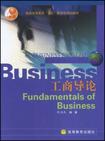工商导论
出版时间:2002-8 出版社:高等教育出版社 作者:陈准民 页数:263
Tag标签:无
前言
改革开放的20年是中国经济高速发展并逐渐融入世界经济的20年。中国加入世界贸易组织是此进程的一个重要里程碑,必将进一步推动中国经济与世界经济的接轨与融合。经济日益全球化的趋势迫切需要我们培养一大批熟练掌握外语、通晓商务知识、熟悉国际商务环境、善于跨文化交际的国际型商务人才。 此类商务人才的成功培养涉及到诸多环节与因素,其中至关重要的是要有一套有助于实现此培养目标的、编写意图明确、针对性强、质量高的教材,因为教材是一切教学活动得以开展的基础与前提。目前涉及商务英语的教材不少,但在系统性、完整性以及语言技能与商务知识的有机结合上都多少存在着不足。 普通高等教育“十五”国家级规划教材--商务英语系列教材是高等教育出版社与在商务英语教学与研究领域起步早、阵容强的对外经济贸易大学、广东外语外贸大学、上海对外贸易学院、上海外国语大学、厦门大学、北京外国语大学、北京工业大学和湖南大学等单位联合推出的一套全新的商务英语系列教材。这套教材在编写设计时特别注意把握好商务活动主题的涵盖面、商务知识的系统性与完整性以及语言技能与商务知识的平衡,在体系上分为商务英语基础课程教材((商务英语听说》、《商务英语阅读》、《商务英语写作》、《商务英语翻译》等,和商务英语专业核心课程教材((工商导论》、《国际经济导论》、《国际贸易实务》等。每本教材自成体系,但整套教材又形成了有机的整体。另外,此套教材不是封闭系列,还将不断有新教材推出。 本套教材体现了编撰者努力将语言技能的训练与商务英语知识的介绍融为一体的编写理念,最终服务于复合型人才培养的目标。编撰者们不仅具有丰富的语言教学经验,而且具备商务活动的实践经验。有些作者本身就是经贸领域的专家学者,他们集教学经验、学术背景与专业经验于一身,有力地保证了这套系列教材的编撰质量。 本套教材在编撰过程中得到了高等教育出版社的大力支持,在此特致感谢。
内容概要
商务英语系列教材为普通高等教育“十五”国家级规划教材,是为适应中国加入世界贸易组织以后对复合型商务人才的需求而编写的,《工商导论》是其中的一本。 《工商导论》作为商务英语专业的一门概论型基础课程教材,全面、系统、概要地介绍了国际经贸理论和知识。全书共分18章,每章后面配有案例分析、翻译讨论、模拟运营等练习,书后附有参考答案。通过学习本教材,学生可以对市场经济及现代工商企业的运作有一个总体印象,并熟悉同企业环境、经营管理、金融财务、法律保险等方面有关的英语词汇和用语,为下一步学习更微观、更具体的课程打下基础。 《工商导论》主要供普通高等教育商务英语专业学生,以及国际贸易、国际经济、国际工商管理等外向型专业的学生使用,同时也可供从事国际商贸工作的人员参考使用。
书籍目录
Chapter 1 Setting Up a BusinessSole ProprietorshipPartnershipCorporationA Special Form: FranchisingChapter 2 Marketing: an OverviewThe Origin of MarketingThe Functions of MarketingThe Marketing MixMarket SegmentationChapter3 Products and PricingTypes of ProductsProduct Life CyclePricingChapter4 Channels6fDistHbutionCommon Channels of DistributionThe Cost and Value of MiddlemenPhysical DistributionModes of TransportationChapter 5 PromotionAdvertisingDo It Yourself or Use an Advertising AgencyPersonal SellingSales PromotionPublic Relations and PublicityWord of MouthChapter6 Moneyand BankingWhat Is Money?What Does Money Do?Types of MoneyThe Financial SystemSavings and Loan AssociationsMoney Supply and the Federal Reserve SystemChapter 7 FinancingShort-term FinancingLong-term Sources of FundsDebt or Equity FinancingFeatures of BondsFeatures of StockChapter 8 AccountingBalance SheetIncome StatementChapter9 The Securities MarketPrimary and Secondary MarketsBuying and Selling StocksBulls and BearsThe Bond MarketWho Buy Securities?Chapter 10 Risk Management and InsuranceApproaches to Managing Business RisksInsurance and Its PrinciplesInsurable RisksInsurance for BusinessFidelity and Surety BondsChapter 11 Business LawTypes of LawContract LawTort LawProperty LawWarrantyNegotiable InstrumentsAgency LawBusiness BankruptcyChapter 13 International BusinessWhy Trade with Other Countries?Other Ways to Go GlobalSpecial Issues in International BusinessChapter 13 Managing Business EnterprisesManagement FunctionsManagement Levels and SkillsSources of ManagersThe Building Blocks of Organizational StructureOrganizational Decision MakingOrganizational StructuresInformal OrganizationThe Strategic Management ProcessChapter 14 Human ResourcesManacjementPlanning for Human ResourcesStaffingTraining and Developing EmployeesDemoting and Terminating EmployeesCompensating EmployeesChapter 15 Motivation and Leadership !The Classical TheoryThe Hawthorne StudiesMaslows Hierarchy of Human NeedsHerzbergs Two-factor TheoryMcGregors Theory X and TheoryOuchis Theory ZStrategies for Motivating EmployeesLeadershipChapter 16 Managing InformationInformation vs. DataHow Computers Work?Application ProgramsThe Management Information System (MIS)Chapter 17 The Environment and ResponsibilitiesFactors of ProductionTypes of Economic SystemEconomic Goals and How to Measure Their AttainmentThe Roles of GovernmentThe Market and CompetitionThe Importance of ProfitsThe Responsibility of BusinessChapter 18 Careers in BusinessSelf-evaluationCareer Opportunities in BusinessSuccessful Job HuntingKey to Exercises of Cloze and Scrambled SentencesKey to TranslationReferences
章节摘录
nsurance is a risk-sharing mechanism whereby manyindividuals contribute to a pool of money. This pool willbe used to compensate those contributors who suffer losses.Those who decide to use this mechanism pay a sum called apremium to an insurance company. In return, the insurancecompany issues an insurance policy, a formal agreement topay the policyholder a specified amount in the event of losses. There are certain basic principles about insurance thatwe should understand. These principles are: insurable interest,utmost good faith, indemnity, contribution, subrogation, andthe doctrine of proximate cause. The principle of insurable interest holds that a personmay not insure against any risk unless he will suffer a loss if therisk occurs. One can insure his house against fire, or his caragainst road accidents, because if any of these things happensthe insured will be adversely affected. One can even insure hisown life (e.g. for his dependents) or the life of his boss if theboss is so important that he will suffer losses in case the bossdies. But, one cannot insure another persons house, car orother properties, because he has no insurable interest in them.He might just be encouraged to see that the insured suffered aloss if he could profit from it without suffering any loss himself. The second principle of insurance is utmost good faith.The insured must tell the insurance company every detail heknows that may affect him when fixing premium and payingany claim later.
图书封面
图书标签Tags
无
评论、评分、阅读与下载
